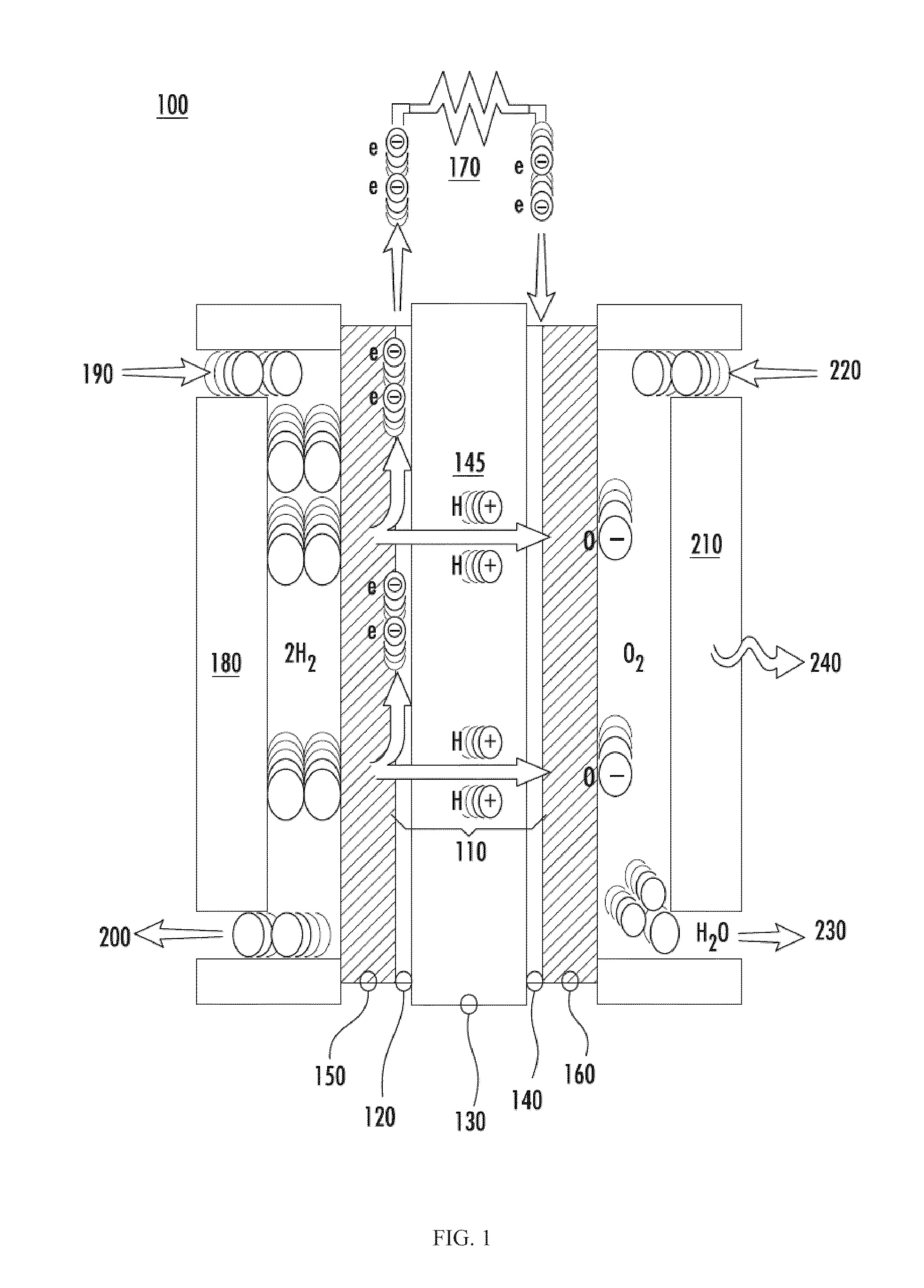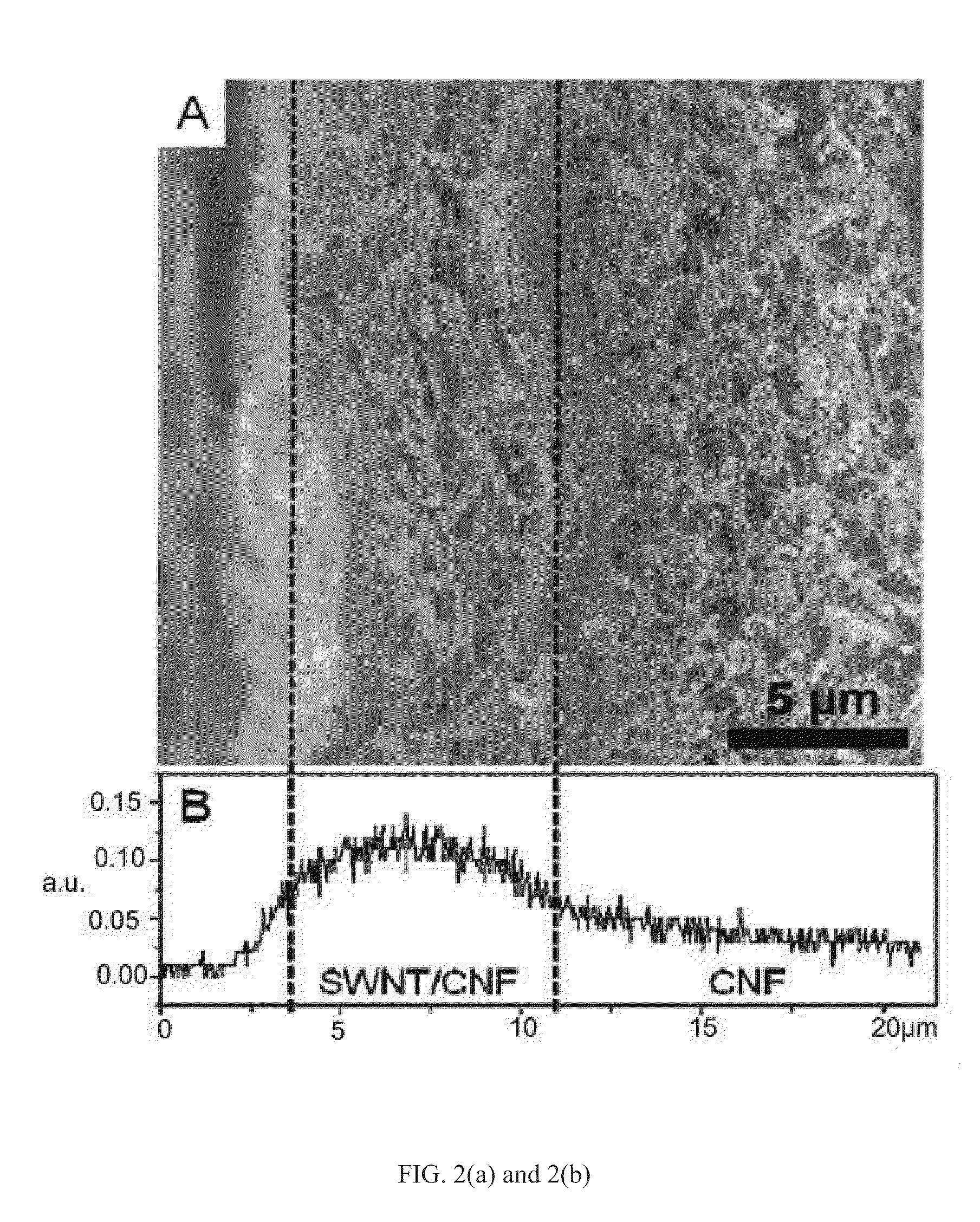Catalytic electrode with gradient porosity and catalyst density for fuel cells
- Summary
- Abstract
- Description
- Claims
- Application Information
AI Technical Summary
Benefits of technology
Problems solved by technology
Method used
Image
Examples
example 1
[0058]An exemplary gradient catalyst structure was prepared by filtrating a 25 wt-% SWNT / 75 wt-% CNF suspension and CNF suspension sequentially under full vacuum. As shown in FIG. 2(a), the CNFs entangle randomly forming a highly porous second layer with a porosity of 90.8% and an average pore size of 85 nm, while smaller pores are formed in the SWNT / CNF layer by adding 25 wt. % fine-sized SWNTs. As a result, the SWNT / CNF first layer has a much larger surface area (105 m2 / g) than that of the CNF layer (24 m2 / g) because of the high aspect ratio of SWNT. After depositing Pt on the layered buckypaper by electrochemical deposition, EDS analysis in FIG. 2(b) showed a gradient distribution of Pt, with over 70% of the Pt distributed in the 7-micron-thick SWNT / CNF first layer. As shown in FIGS. 2(c) and 2(d), a large amount of Pt deposited on the surface of the SWNT / CNF first layer while fewer Pt nanoparticles deposited an the surface of the CNF second layer. Thus, FIG. 2 provides a qualita...
example 2
[0061]The Pt / LBP with tailored gradient structure has demonstrated promising Pt utilization and stability of supports in spite of relative large Pt particle size. Considering the negligible improvement of anodic oxygen reduction reaction (ORR) activity by using Pt / LBP, such high cell performance is believed to result from the inventive microstructure of the gradient catalyst structure. To evaluate the effect of the microstructure on the fuel cell performance, two conventional single-layer buckypaper MEAs were compared in terms of their polarization curve and electrochemical impedance (EIS). The conventional buckypapers consist of the mixture of SWNT and CNF in a weight ratio of 1:3 (described as SF13) or 1:9 (described as SF19) with a thickness of 14 μm. Pt was deposited on each of the conventional buckypapers and the Pt / LBP layered buckypaper under the same conditions, consequently each had nearly the same catalyst nanoparticle size. Nafion was impregnated on the conventional bucky...
example 3
[0064]In W. Zhu et al., Durability Study on SWNT / Nanofiber Buckypaper Catalyst Support for PEMFCs, Journal of the Electrochemical Society (2009), a SWNT / CNF buckypaper with Pt catalyst nanoparticles demonstrated good durability under an accelerated degradation test in a simulated PEM fuel cell cathode environment. The good durability is believed to be due to the high corrosion resistance resulting from the high degree of graphitization of the CNFs. Subsequently, the durability of catalyst support for the Pt / LBP-based MEA disclosed herein was evaluated per DOE's test protocol set forth in U.S. Dept. of Energy, Hydrogen, Fuel Cell &Infrastructure Technologies Program Multi-Year Research, Development and Demonstration Plan (2007). FIG. 5 shows the polarization curves at different time intervals during the 200-hour durability test. The mass activity measured at 900 mV lost only 57.6% of initial activity after 200 hours of operation, which is much better than that obtained in conventiona...
PUM
| Property | Measurement | Unit |
|---|---|---|
| Weight | aaaaa | aaaaa |
| Efficiency | aaaaa | aaaaa |
| Porosity | aaaaa | aaaaa |
Abstract
Description
Claims
Application Information
 Login to View More
Login to View More - R&D
- Intellectual Property
- Life Sciences
- Materials
- Tech Scout
- Unparalleled Data Quality
- Higher Quality Content
- 60% Fewer Hallucinations
Browse by: Latest US Patents, China's latest patents, Technical Efficacy Thesaurus, Application Domain, Technology Topic, Popular Technical Reports.
© 2025 PatSnap. All rights reserved.Legal|Privacy policy|Modern Slavery Act Transparency Statement|Sitemap|About US| Contact US: help@patsnap.com



